In July 2007, in coordination with an infrastructure construction project, the Datong Municipal Institute of Archaeology conducted rescue excavations on 31 tombs of the Liao and Jin dynasties at Xihuan Road in Datong City. The cemetery is located in the southwest area of the Ming dynasty Datong City site. The geographical coordinates are 40°04’25.5’’N, 113°15’25.2”E, and the elevation is 1,065 meters above sea level. The surrounding terrain of the cemetery is relatively flat. The tombs are adjacent to the Liao dynasty mural tomb at Datong Locomotive Factory in the south,[1] and to the tomb of Xu Congyun of the Liao dynasty in Xintianbao Hui Autonomous Township in the southwest[2] (Figure 1). Below is a brief report on the excavations of Tombs M1 and M6.

BURIAL STYLE
(A) Tomb M1
It is a single-chamber brick tomb consisting of a ramp, a passage and a burial chamber, facing south, oriented at 180 degrees. The tomb is built with long, gray, grooved bricks bonded with fine loess clay. The burial chamber is circular in plan view. The wall and the passage are built with two courses of stretchers between every course of rowlocks, and the vaulted ceiling is made with stretchers by tapering each course inward into a cupola-like corbeled dome. Four murals are painted on the walls (Figures 2 and 4).

- 1-3. Pottery double-eared fu-cauldrons
- 4-6. Pottery pen-basins
- 7, 8. Pottery double-eared guan-jars
- 9-13. Pottery guan-jars with everted bellies
- 14. Pottery ring-footed zhen-pottery wheel
- 15, 16. Porcelain pan-plates
- 17, 18. Porcelain wan-bowls
Ramp: It is to the south of the passage, rectangular in plan view, oriented in a north-south direction on the same axis as the burial chamber. It is 6.5 m long and 0.7 m wide at the top. The opening of the ramp is 0.3 m below the current ground surface, and its northern end is 3.8 m below the current ground surface. The excavation did not reach the bottom of the front part because that portion of the ramp is covered by a modern building.
Passage: Connecting to the burial chamber, the passage is rectangular in plan, 0.5 m long, 0.6 m wide and 0.9 m high. The walls on the left and right sides are built with two courses of header bond over each course of rowlocks bond with two sets of such combination. The vaulted ceiling starts at a height of 0.6 m in a stretcher bond. On the upper part there is a suspended door canopy, which is made of a single layer of bricks and is 1.4 m high. A layer of staggered floor tiles is laid at the bottom.

Burial chamber: It is circular in plan view with a diameter of 2.8 m. The circular earthen pit in which the burial chamber is built has a bottom diameter of 2.1 m. The wall is built with long, gray, grooved bricks in the bond of two courses of stretchers between every course of rowlocks. The vaulted ceiling starts at a height of 1.4 m, tapering each course inward into a cupola-like corbeled dome, covered on top by a stone slate. The height of the ceiling is 2.6 m. Located in the middle of the south wall, the arched tomb entrance was sealed by bricks. The remaining three layers of bricks are in rowlock courses, with, respectively, nine, nine and ten bricks in each layer, from bottom to top. Remains of black paint can be found on some of these bricks. A layer of staggered floor tiles is laid at the bottom of the burial chamber. Each brick is 30 centimeters long, 16 cm wide and 6 cm thick, with 18 to 20 molded grooves on the reverse side. At the rear of the burial chamber is a coffin platform, 1.6 m long, 0.4 m wide and 0.16 m high, taking up a quarter of the burial chamber. On the top of the coffin platform are laid staggered polished tiles, and the platform is painted with a red lacquer coating. Due to water seepage, the urn containing cremated human remains was moved to the middle of the tomb. The tomb is a husband-and-wife joint burial. In front of the coffin platform are placed 18 pottery and porcelain artifacts, including guan-jars, pen-basins and fu-cauldrons (Figure 5).
Murals: Four walls of the burial chamber are smoothly plastered with grass-tempered mud, 2 cm thick, on top of which white lime paste is applied about 0.2 cm thick. The mural on the ceiling has come off. The murals on the vertical walls mostly remain intact. Columns painted in red divide the murals into four scenes. The characters and scenes are rendered with meticulous brushwork and in rich colors. Layered shading can clearly be seen along the outlines.



(1) South wall: The arched tomb entrance is in the middle of the mural with a red frame 18 cm wide drawn along the outer border. A female servant is painted to the left of the entrance, 0.8 m tall, standing sideways, facing the entrance. The image of her face has peeled off. Her hair is tied into a bun covered by a black cloth tied with a red sash. She wears a bluish-gray, wide-sleeved gown that closes on her right side; a long red skirt; and a red inner jacket visible at her neck. Her left hand is held open casually at her chest, and her right hand holds some object. A male servant is painted to the right, 0.9 m tall, standing sideways, facing the entrance. Wearing a black hat, he has a rosy complexion, thick eyebrows, a short mustache, deep socketed eyes looking ahead, big ears, a high nose bridge, closed lips and a focused look. He wears a bluish-gray, wide-sleeved, round-collared robe that is long enough to touch the ground, and his light red inner jacket is visible at his neck. He holds a double-layered black waist sash in his left hand, and in his right hand there is a slender staff approximately as long as he is tall (Figure 7).

(2) West wall: In the middle of the mural, toward the left, a clothes stand is painted, on the upper ends of which are two red carved ornaments. On the clothes stand hang sky blue, beige, bluish-gray, yellowish-brown and pink clothes. The garment to the far right has a green-diamond grid pattern, each diamond of which has a small red decorative flower in it. On another garment, a ring-shaped pei-pendant, probably a jade huan-disc, hangs at the waist. In front of the clothes stand there is a long rectangular table, on which are placed four round plates, black on the outside and red inside, holding, respectively, a headdress, bracelets, hairpins and combs (Figure 8). To the left side of this long table stands a female servant with a full height of 0.63 m. Her long hair is rolled upward and tied into a round bun covered by a gauze net and tied with a red sash. The front edge of her hair bun has a curved shape and has hair pins embedded into it as ornaments. She has a rosy complexion, square face with a broad forehead; below curved eyebrows, her big eyes gaze ahead. She has a high nose bridge, closed lips with raised ends and a plump body. She wears a pink, wide-sleeved outer garment on top, along with a bluish-gray inner garment visible at the neck, and wears a long blue skirt at the bottom. She holds a large round tray in her right hand, with her left hand supporting the edge of the tray (Figure 9). In front of her is a square table, on which are placed, from left to right, a white narrow-necked and lidded zhihu-ewer, a red oval pan-plate, three sets of tuo-saucers and zhan-cups, and a red wrapped package resembling a lobed melon. The tuo-saucers have red bodies, and each holds a white porcelain zhan-cup. The upper part of the wrapped package is tied to form a flower-shaped top. This part of the mural shows scenes of food and drink preparation. Another clothes stand is painted to the north side of the square table, the ornaments on the upper ends of which are essentially the same as those on the stand described above. On the stand hang beige, bluish-gray and pink clothes, with a ring-shaped pei-pendant at the waist of one garment. In front of the clothes stand there is another long rectangular table, outlined in red. On top of it, three round plates, black on the outside and red inside, holding objects, are faintly visible. Behind the clothes stand there is a servant boy with a full height of 0.63 m He wears a melon-shaped cap with scalloped trim at its bottom. He has a rosy complexion, round face with a flat forehead, thin and long eyebrows, double-fold eyelids, a garlic-clove-shaped nose, and a small mouth with thin lips. He wears a long, bluish-gray, wide-sleeved gown, and his red inner jacket is visible at his neck. With both hands hidden inside his sleeves, he gazes ahead and stands respectfully behind the clothes stand (Figure 10). To his right stand two wooden chests, one red and the other beige. The red chest has a flat lid, and the beige chest has an arched lid. Both chests seem to be locked.



(3) North wall: The curtains painted at the upper part of the mural are damaged. Under the curtains there is a four-panel screen 2 m tall, painted with cranes (Figure 11). Each of the four cranes is 0.9 m tall. The major part of each crane is represented in line drawing; its crown is colored with cinnabar; and its eyes, long neck, body and tail are rendered in ink, showing high contrast between black and white. Each crane has a fluid shape and rich plumage, a fine long neck, a red crown, round eyes, a long beak, slender legs and a drooping tail. From right to left, each of the four cranes has a different pose: standing and looking back (Figure 12), raising head and proudly looking forward (Figure 13), bowing forward and foraging for food (Figure 14), and bending neck backward playfully (Figure 15). In front of the screen is a couch for the tomb occupant. Balustrades and wangzhu-balustrade posts were initially drawn with red paint and gilt with powder gold. Each plain round post has geometric patterns drawn in ink around the capital and base. In between the wangzhu-balustrade posts there are difu-groundsills, lanban-fencing boards, dou-blocks, shuzhu-king posts and xunzhang-handrails as barriers and supports. These components were then outlined in ink and painted in red. The lower part of the mural is damaged and no longer visible.

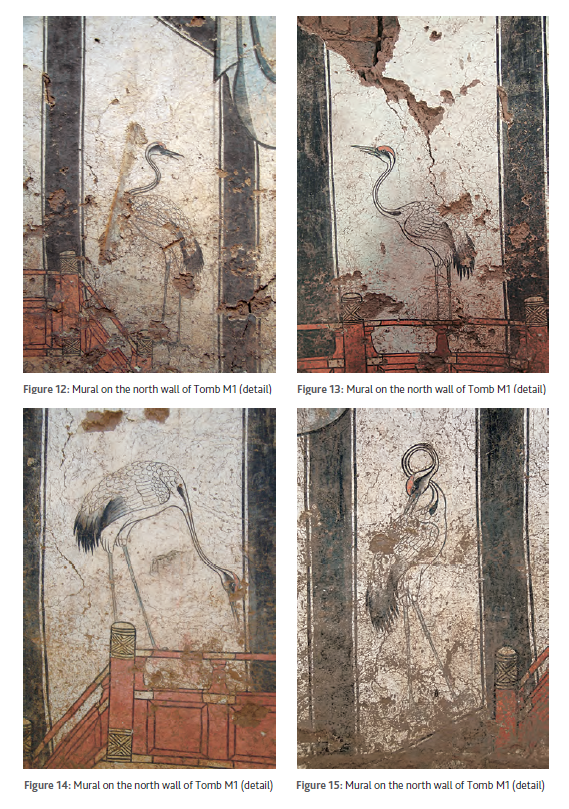
(4) East wall: The lower part of the mural is damaged and no longer visible. A clothes stand is painted to the left side in the mural. On the upper ends of the stand are two red carved ornaments; at the lower part there are two red horizontal bars; and triangle-shaped supports are shown at the bottom. On the stand hang beige, light green, bluish-gray, pink and brown clothes. On one of the garments hangs a ring-shaped pei-pendant, accompanied by a string of black beads. In front of the clothes stand there is a square brown table, on which a round white box is placed. A red lid is next to the box, with two bluish-gray sashes on top of it. To the right a boy attendant 0.63 m tall is painted. The top of his head is shaved, and he has loose hair on his forehead and temples, two locks of hair hanging in front of his ears, and the remainder of his hair rolled into a round bun at the back of his head. He has a wide forehead, a long and fine-featured face, slanting eyebrows and big eyes, a straight and tall nose bridge, and closed lips. He is dressed in a gray, round-collared gown with tight sleeves, wears a red inner jacket visible at his neck, and has a red sash tied at his waist with a ring-shaped pei-pendant. He holds a sutra scroll in his left hand and a sutra book in his right hand in front of the chest, bending his body and looking toward the master’s bedchamber. A candle stand is painted behind the boy attendant. It has a lotus-shaped, bluish-gray stand on top, and has a bamboo-like spike, also bluish-gray; it holds a burning candle with a slender body and red flame on top (Figures 16 and 17).


(B) Tomb M6
This tomb is an earthen cave tomb with a long sloping ramp, consisting of the ramp and the burial chamber, facing south and oriented at 180 degrees (Figure 3).
Ramp: It is located in the southern end of the tomb, rectangular in shape, 4.8 m long and 0.94 m wide. Its northern end is 3.9 m below the ground surface, and was not excavated since it is covered by a modern construction.
Burial chamber: It is square in plan view, and on the same axis as the ramp. It is wider at the south side and narrower at the north, higher at the front and lower at the rear. The length north to south is 1.6 m; the width east to west is 1.6 m to 1.8 m; and the pit is 1 m to 1.2 m deep with a collapsed top. The bottom of the tomb is 3.9 m below the current ground surface. Inside the burial chamber there is a sarcophagus 0.6 m long, 0.4 m wide and 0.4 m high, with a trapezoidal roof-shaped lid connected to it by tenons and mortises. The entire surface of the sarcophagus is engraved with geometric patterns. The inner wall of the lid was engraved with an inscription. Despite damage from corrosion, three lines of characters still remain. They read: “The spirit […] of […] [née] Liu, deceased aunt [wife of father’s younger brother – Trans.] of […] […]zhao, on the fourteenth day of the first moon in the fourth year of the Dading reign.” Thus we know that the tomb occupant is the woman née Liu. The tomb entrance was sealed by a quartzite slab. A black-glazed chicken-leg ping-vase and a plum-blossom ping-vase were placed behind the sarcophagus; a yellow-glazed wan-bowl and two white-glazed pan-plates were in front of the sarcophagus, and a white-glazed die-saucer, a yellow-glazed wan-bowl and a black-glazed long-necked ping-vase were at the right side of the sarcophagus (Figures 6 and 27).
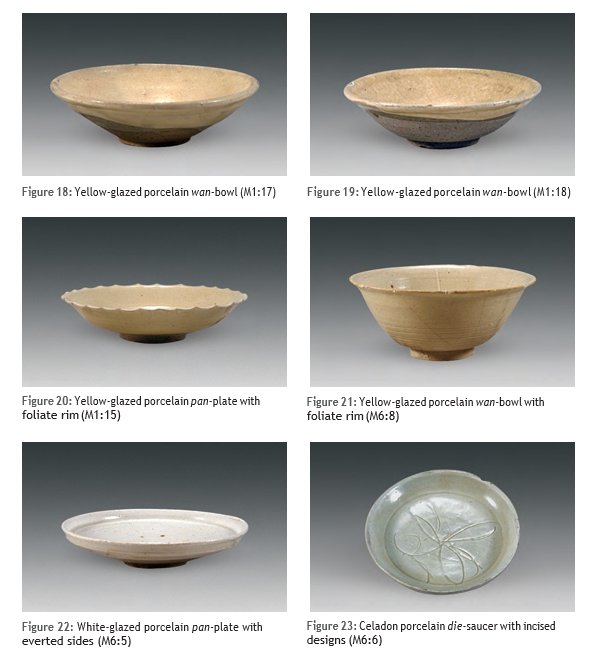
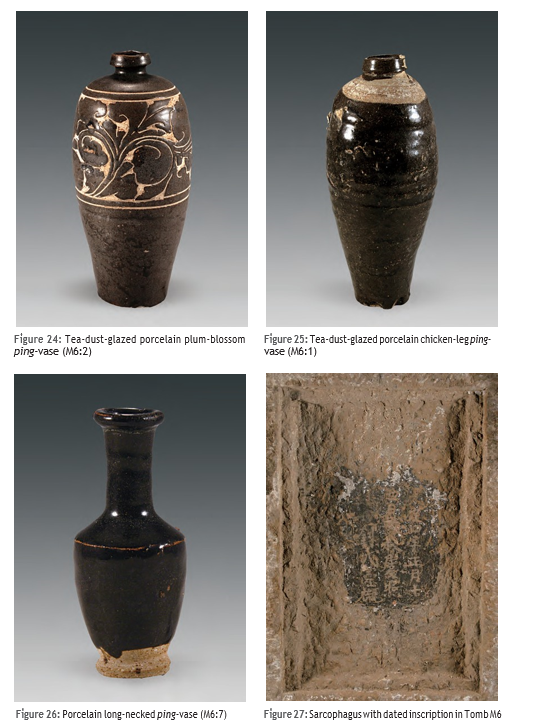
GRAVE GOODS
(A) Tomb M1
A total of 15 artifacts were found, including pottery fu-cauldrons, pottery pen-basins, guan-jars and a zhen-pottery wheel, and porcelain wan-bowls and pan-plates.
Pottery double-eared guan-jars (2 items): Both items are of the same shape and size. M1:7 is gray temperless pottery. It has a straight mouth, a square-edged lip and a short neck. The outer rim of its mouth is decorated with an incised bowstring. It has a pair of ears symmetrically attached at the shoulder, a small flat base, underlying triangle decoration on its shoulder, and an underlying bowstring on its belly. The mouth diameter is 7.4 cm, base diameter 6 cm and height 14.5 cm (Figure 28 and Figure 33:1).
Pottery guan-jars with everted bellies (5 items): All five items have the same shape and size. M1:9 is gray temperless pottery. It has a contracted mouth, a square-edged lip, a short neck, an everted belly, a flat base and a knob-shaped lid. It has a mouth diameter of 8.8 cm, belly diameter of 16.4 cm, base diameter of 12 cm and height of 12 cm (Figure 29 and Figure 33:2).
Pottery pen-basins (3 items): M1:4 is gray temperless pottery. It has a rounded lip, and its sides are slanting and contracted inward. The lip and the inside of the sides are densely covered with underlying bowstrings. Its rim diameter is 25.8 cm, base diameter 13.2 cm and height 8.4 cm (Figure 30 and Figure 33:3).
Pottery double-eared fu-cauldrons (3 items): M1:1 is sand-tempered gray pottery. It has a sharp lip, a recessed groove decorating the area inside the mouth rim, two false ears symmetrically attached at the rim and a round base. Two fish designs are engraved on the interior bottom of the fu-cauldron, between which there is a jellyfish pattern. Its mouth diameter is 11.6 cm and the full height 7.5 cm (Figure 31 and Figure 33:6).
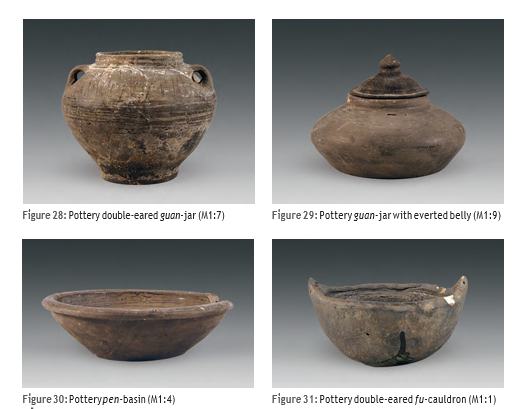
Pottery ring-footed zhen-pottery wheel (1 item: M1:14). It is temperless gray pottery. It has a rounded lip; its rim is turned in on the inside and slightly everted downward on the outside; its opening is shaped like a plate; and it has 14 pores at the bottom, a flat base, a tall ring foot, and hand rubbed lines on it. The mouth rim diameter is 18 cm, base diameter 10.3 cm and height 14.6 cm (Figure 32 and Figure 33:5).

Porcelain wan-bowls (2 items): M1:17 has a flaring mouth, rounded lip, rounded sides and a shallow ring foot. It has a pale yellow body with black impurities, polished with engobe, glazed in yellow on the inside and half glazed in yellow on the outside. It has a mouth rim diameter of 14.3 cm, base diameter of 5 cm and height of 4.5 cm (Figure 18 and Figure 33:7). M1:18 has a flaring mouth rim, rounded lip, rounded sides and a shallow ring foot. The body is dark yellow, polished with engobe, its inside glazed in dark yellow and its outside partially glazed in dark yellow. It has a mouth diameter of 14.5 cm, base diameter of 5.7 cm and height of 4.5 cm (Figure 19 and Figure 33:8).
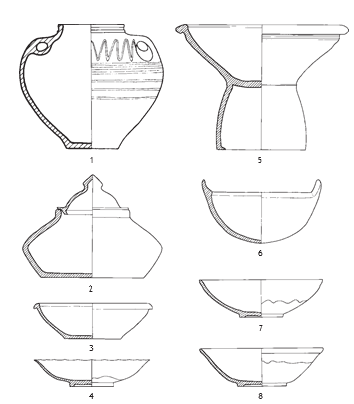
Porcelain pan-plates (2 items): Both items are of the same shape and size. M1:15 has a foliate rim, rounded sides and a ring foot. It has a fine white body that is covered with transparent yellow glaze. Its rim diameter is 13.5 cm, base diameter 5 cm and height 3.2 cm (Figure 20 and Figure 33:4).
(B) Tomb M6
A total of eight artifacts were unearthed. All of them are porcelains.
Wan-bowls with foliate mouths (2 items): Both items have the same shape and size. M6:8 has a flaring mouth rim in the shape of a flower with six lobes, deep rounded sides and a ring foot. There are six raised vertical ridges on the inside of the bowl which together form a flower, with a circle pattern at the center. It has a grayish-white body that is covered with transparent yellow glaze. The mouth rim is unglazed, the ware having been fired upside down. The mouth rim diameter is 13.3 cm, base diameter 4.3 cm and height 5.5 cm (Figure 21 and Figure 34:1).
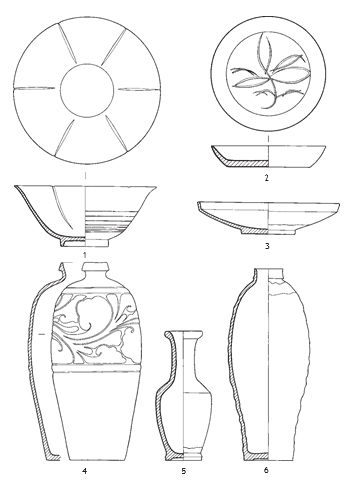
Pan-plates with everted sides (2 items): Both items have the same shape and size. M6:5 has a shallow opening, everted sides and a ring foot. It has a fine white body covered with transparent glaze. Its color is reminiscent of crescent moon white. It has a mouth rim diameter of 13 cm, base diameter of 4.9 cm and height of 2.9 cm (Figure 22 and Figure 34:3).
Die-saucer with incised designs (1 item: M6:6): It has a flaring mouth rim, everted sides and a flat base. A blooming lotus flower with its stalk and leaves is incised at the bottom of the interior in smooth lines in a natural and vivid composition. Its grayish-white body is fully covered with pale bluish-yellow transparent glaze. Its mouth rim diameter is 16.4 cm, base diameter 12 cm and height 3 cm (Figure 23 and Figure 34:2).
Plum-blossom ping-vase (1 item: M6:2): It has a small mouth, sharp rounded lip, short constricted neck, wide shoulder, a drooping rounded belly and shallow ring foot. There are two incised bowstrings, one under the shoulder and the other in the middle of the belly. In the space between these two bowstrings is an incised pattern of intertwined leaves; the pattern is tea-dust glazed, in contrast to the incised background, which reveals the pale yellow body. At the lower part of the belly, irregular ring lines can be seen in a consistent color, and the pattern is rough. The body is pale yellow and covered with tea-dust glaze. The mouth diameter is 4 cm, belly diameter 16 cm, base diameter 10 cm and height 36 cm (Figure 24 and Figure 34:4).
Chicken-leg ping-vase (1 item: M6:1): It has a small mouth, a sharp rounded lip, a short constricted neck, a scraped unglazed circle at the shoulder, a chicken-leg-shaped belly and a shallow ring foot. There are irregular ring lines at the belly. The body is white and covered with tea-dust glaze. The mouth diameter is 5 cm, maximum belly diameter 15 cm, base diameter 9 cm and height 35 cm (Figure 25 and Figure 34:6).
Long-necked ping-vase (1 item: M6:7): It has a mouth with a lip, a long slender neck, a slanting shoulder, a drooping rounded belly and a flared ring foot. A ridge is seen at the joint of the shoulder and belly. The body is bluish-gray with black impurities and is covered with black glaze except for the bottom part. Its mouth diameter is 3.4 cm, maximum belly diameter 5 cm, base diameter 3.3 cm and height 11.5 cm (Figure 26 and Figure 34:5).
CONCLUSIONS
In this cemetery, approximately half of the tombs are earthen cave tombs with long ramps, and the other half are brick tombs. Among them, the earthen cave tombs with long ramps and the brick tombs with round cupola-like corbeled domes are the typical tomb styles of the Western Capital area [present-day Datong City – Trans.] during the Liao and Jin dynasties. These tombs were arranged in a regular order, and should belong to several lineage cemeteries. They can be dated to the early to late Liao dynasty, and to the period when the Liao and Jin dynasties coexisted.
According to the characteristics of the burial customs of Liao tombs in the Datong area, the shape, form and tomb structure of Tomb M1 are similar to those of the Liao dynasty tomb found at Datong Locomotive Plant,[3] and the practice in Tomb M1 of not representing the tomb occupant in the mural on the northern wall is similar to the practice observed in the Liao dynasty mural tomb at Dongfengli Neighborhood in Datong City.[4] Therefore, we propose that this tomb should be dated to the late Liao dynasty. The balustrades seen in the mural follow the typical style of stone-carved balustrades with xunzhang-handrails seen in the Liao and Song dynasties. In particular, the headdresses on the mural figures are in a theatrical style, the first time this has been seen in the Liao dynasty tombs in Datong City. It provides new material evidence for the study of funeral customs and headdress styles in north China and among the ethnic minorities in the Datong area.
The two yellow-glazed porcelain wan-bowls in Tomb M1 were both half glazed on the outside in a less pure color, features similar to those of porcelain wares from the Yaozhou kiln in the Jin dynasty, so it is likely that the porcelain products unearthed from Tomb M1 are Jin dynasty Yaozhou wares.[5] The sarcophagus in Tomb M6 bears an inscription dating it to the fourth year of the Dading reign period of the Jin dynasty (1164 CE), which confirms that the tomb dates to the early Jin dynasty. Given that incised designs were found on the tea-dust-glazed plum-blossom ping-vase in the tomb, and that the black glaze on the long-necked ping-vase does not cover the bottom part – features similar to those of porcelain products from the Hunyuan kiln in the Jin dynasty – we propose that these porcelains are probably Hunyuan wares. The porcelains from these two tombs provide valuable information for the study of the development of Jin dynasty porcelains.
____________________________________________
Field Crew Chief: Junxi Liu
Field Crew: Baijun Li, Weiwei Jiang, Qingsheng Yang and Zeming Wei
Drawings: Weiwei Jiang
Photography: Baijun Li
Prepared by: Baijun Li
_____________________________________________
References Cited
1. Datong Municipal Institute of Archaeology 大同市考古研究所. 2006. “Shanxi Datong jiche chang Liaodai bihua mu” 山西大同机车厂辽代壁画墓 (The Mural Tomb of the Liao Dynasty Found at Datong Locomotive Plant, Shanxi Province). Wenwu 文物 (Cultural Relics) No. 10.
2. Department of Archaeology of Shanxi University 山西大学考古系 et al. 2005. “Shanxi Datong shi Liaodai jun jiedushi Xu Congyun fufu bihua mu” 山西大同市辽代军节度使许从赟夫妇壁画墓 (The Mural Tomb of the Military Commissioner of Datong Military Prefecture Xu Congyun and His Wife of the Liao Dynasty in Datong City, Shanxi Province). Kaogu 考古 (Archaeology) No. 8.
3. See [1] above.
4. Datong Municipal Institute of Archaeology 大同市考古研究所. 2013. “Shanxi Datong Dongfengli Liaodai bihua mu” 山西大同东风里辽代壁画墓 (The Excavation of the Mural Tomb of the Liao Dynasty at Dongfengli Neighborhood, Datong City, Shanxi Province). Wenwu 文物 (Cultural Relics) No. 10. For English translation, see Chinese Cultural Relics, Vol. 1, No. 1, 2014, pp. 63-79.
5. Museum of Yaozhou Kiln 耀州窑博物馆. 2007. Chenlu Yaozhou yao ci jingcui 陈炉耀州窑瓷精萃 (The Best of Yaozhou Wares in Chenlu Town). Cultural Relics Press, Beijing.
Wenwu (Cultural Relics) Editor: Guanhua Yang
Translated by Xin Chen, D.Phil., Associate Editor, Chinese Cultural Relics; Independent Scholar, New York City, New York, United States
This article was originally published as “Shanxi Datong Xihuanlu Liao Jin mu fajue jianbao” 山西大同西环路辽金墓发掘简报 in Wenwu (Cultural Relics) No. 12, 2015, pp. 46-59.